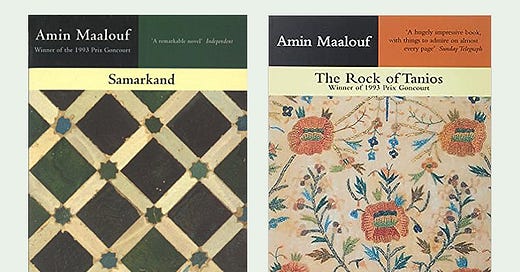Amin Maalouf, the Lebanese-born author, began as a journalist in his native Beirut, then moved to France at the outbreak of the Lebanese civil war.
Samarkand:
“At the bottom of the Atlantic there is a book. I am going to tell you its history.” With this teaser, Amin Maalouf begins his tale of Samarkand.
My old interest in medieval Central Asia drew me to this novel. How could I pass up a story set in 11th-century Samarkand? (More, please!)
This dual time-period novel introduced me to two new historical epochs: the life of Omar Khayyam during the Seljuk Empire, and the Persian Constitutional Revolution of 1905-1907. The story blends the development of Khayyam as a poet and his writing of the Rubaiyaat within the context of his life and the politics of the time. It also traces the history of a fictional/original manuscript of the Rubaiyaat as it passes through the stronghold of the Assassins, into the hands of a 20th-century Persian princess, and ends up on the Titanic.
This BBC article untangles Maalouf’s fictional tale from his inspiration—an early 20th-century embellished volume that did go down with the ship.
You can find summaries and reviews of Samarkand here and here.
The Rock of Tanios:
As with Samarkand, The Rock of Tanios led me through a time and place of which I had no prior knowledge, even though my Work in Progress moves through the same geography. Twelve hundred years pass between my subject and the world of Maalouf’s novel and yet I enjoyed the immersion into 1830s Lebanese mountain village life. This story of personal passion, murder, and fateful decisions expands into the wider political context—when Egypt, the Ottoman Empire, England, and France vied for control of the region. All new territory for me.
But this is the attraction of reading historical fiction from off the beaten path. It opens up new adventures and the chance to see the world through another’s experience. Some say that stories help us develop empathy. They also help us understand ourselves.
You can find summaries and reviews of The Rock of Tanios here and here.
But Wait! There’s More!
Long after I’d read these two novels, I realized the author is the same as that of The Crusades Through Arab Eyes—the book I read way back in the early ‘90s which had such a powerful effect on me. It was, in fact, one of the sparks that ignited my own slow movement toward my Work In Progress. You can find more on that here.
You can find summaries and reviews of The Crusades Through Arab Eyes here and here.
*****This article is a revision and expansion of one that was originally posted on my Long Ago & Far Away WordPress blog. I am slowly bringing some material from there to Substack because it has evergreen value.
It also buys me time while I circle a fresh article that is going to require some deep work. I am circling because my Day Job is currently sucking all the extra deep work energy I have at the moment. The first reservoir of deep work energy must go to my Work In Progress during the wee morning hours. I’m also circling because I know that once I sit before it, it’s going to rush out like a firehose of garbled thoughts that will take a lot of sifting to make readable. That’s normal. But I fear other responsibilities will rip me away mid-stream and that’s gonna hurt. So, I’m waiting for a time when I can do the deep work without a looming—gotta stop this and go do, whatever. This is seldom an issue for me and when it is, I usually find that my imagined, “I need a three-hour-time-slot set aside to get through this,” ends up only needing about 45 minutes. So, I will get there eventually.
*******You might notice that I am shifting my newsletter delivery goal from weekends to weekdays—either Wednesdays or Thursdays, so I’m a bit short on time this week in order to make the jump.
Have you read any of Maalouf’s work? Are you likely to add any of these to your TBR stack?






I really want to read both! Thanks so much for sharing these books